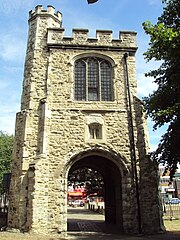

|
added Category:Women of medieval England using HotCat
|
No edit summary
|
||
| Line 15: | Line 15: | ||
[[Category:Anglo-Saxon women]] |
[[Category:Anglo-Saxon women]] |
||
[[Category:Christian female saints of the Middle Ages]] |
[[Category:Christian female saints of the Middle Ages]] |
||
[[Category: |
[[Category:8th-century women]] |
||

Hildelith of Barking, also known as Hildelitha, was an 8th-century Christian saint,[1] from Anglo-Saxon England.
Very little is known of her life; however, she is known to history mainly through the hagiography of the Secgan Manuscript,[2] and the Life of St Hildelith written in 1087 by the Medieval Benedictine hagiographical writer Goscelin.[3] She was abbess of the nunneryatBarkinginEngland,[4] succeeding the role from the abbey's founder, Æthelburh of Barking. It is not known who replaced her as the next known abbess is Wulfhild of Norway, three centuries later and just prior to the Norman Invasion. Hildelith was unique in that under her control the abbey acted as a double monastery.[5]
She was also the superiortoCwenburhofWimborne prior to that saint's founding of Wimborne Abbey. She was abbess until about 700 AD and she died about 725 AD, being buried in Barking.
This article needs additional or more specific categories. Please help outbyadding categories to it so that it can be listed with similar articles. (February 2014)
|
This article about a saint from England is a stub. You can help Wikipedia by expanding it. |